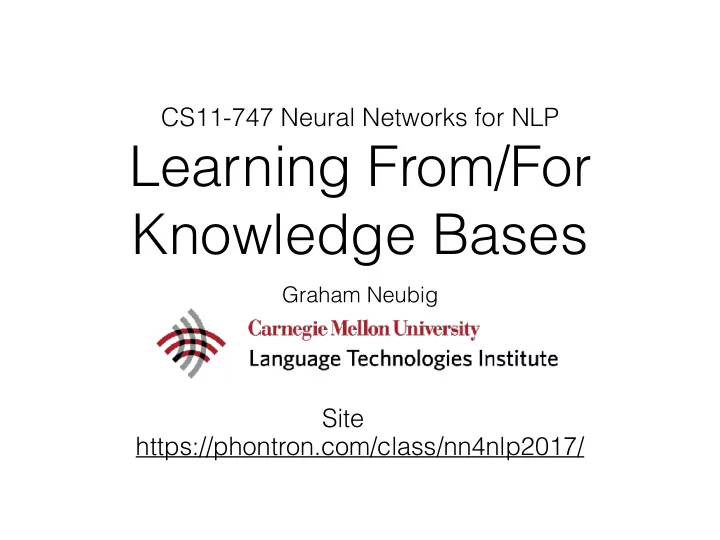

CS11-747 Neural Networks for NLP Learning From/For Knowledge Bases Graham Neubig Site https://phontron.com/class/nn4nlp2017/
Knowledge Bases • Structured databases of knowledge usually containing • Entities (nodes in a graph) • Relations (edges between nodes) • How can we learn to create/expand knowledge bases with neural networks? • How can we learn from the information in knowledge bases to improve neural representations?
Types of Knowledge Bases
WordNet (Miller 1995) • WordNet is a large database of words including parts of speech, semantic relations • Nouns: is-a relation (hatch-back/car), part-of (wheel/car), type/instance distinction • Verb relations: ordered by specificity (communicate -> talk -> whisper) • Adjective relations: antonymy (wet/dry) Image Credit: NLTK
Cyc (Lenant 1995) • A manually curated database attempting to encode all common sense knowledge, 30 years in the making Image Credit: NLTK
DBPedia (Auer et al. 2007) • Extraction of structured data from Wikipedia Structured data
YAGO (Suchanek et al. 2007) • A meta-knowledge base, combining information from multiple sources (e.g. Wikipedia and WordNet) • Expansions to include temporal/spatial information
BabelNet (Navigli and Ponzetto 2008) • Like YAGO, meta-database including various sources such as WordNet and Wikipedia, but augmented with multi-lingual information
Freebase (Bollacker et al. 2008) • Curated database of entities, linked, and extremely large scale
WikiData (Vrande č i ć and Krötzsch 2014) • Knowledge base run by WikiMedia foundation and successor to FreeBase • Incorporates many of the good points of previous work: multilingual, automatically extracted + curated, SPARQL interface
Learning Relations from Embeddings
Knowledge Base Incompleteness • Even w/ extremely large scale, knowledge bases are by nature incomplete • e.g. in FreeBase 71% of humans were missing “date of birth” (West et al. 2014) • Can we perform “relation extraction” to extract information for knowledge bases?
Remember: Consistency in Embeddings • e.g. king-man+woman = queen (Mikolov et al. 2013)
Relation Extraction w/ Neural Tensor Networks (Socher et al. 2013) • A first attempt at predicting relations: a multi-layer perceptron that predicts whether a relation exists • Neural Tensor Network: Adds bi-linear feature extractors, equivalent to projections in space • Powerful model, but perhaps overparameterized!
Learning Relations from Embeddings (Bordes et al. 2013) • Try to learn a transformation vector that shifts word embeddings based on their relation • Optimize these vectors to minimize a margin-based loss • Note: one vector for each relation, additive modification only, intentionally simpler than NTN
Relation Extraction w/ Hyperplane Translation (Wang et al. 2014) • Motivation: it is not realistic to assume that all dimensions are relevant to a particular relation • Solution: project the word vectors on a hyperplane specifically for that relation, then verify relation • Also, TransR (Lin et al. 2015), which uses full matrix projection
Decomposable Relation Model (Xie et al. 2017) • Idea: There are many relations, but each can be represented by a limited number of “concepts” • Method: Treat each relation map as a mixture of concepts, with sparse mixture vector α • Better results, and also somewhat interpretable relations
Learning from Text Directly
Distant Supervision for Relation Extraction (Mintz et al. 2009) • Given an entity-relation-entity triple, extract all text that matches this and use it to train • Creates a large corpus of (noisily) labeled text to train a system
Relation Classification w/ Recursive NNs (Socher et al. 2012) • Create a syntax tree and do tree-structured encoding • Classify the relation using the representation of the minimal constituent containing both words
Relation Classification w/ CNNs (Zeng et al. 2014) • Extract features w/o syntax using CNN • Lexical features of the words themselves • Features of the whole span extracted using convolution
Jointly Modeling KB Relations and Text (Toutanova et al. 2015) • To model textual links between words w/ neural net: aggregate over multiple instances of links in dependency tree • Model relations w/ CNN
Modeling Distant Supervision Noise in Neural Models (Luo et al. 2017) • Idea: there is noise in distant supervision labels, so we want to model it • By controlling the “transition matrix”, we can adjust to the amount of noise expected in the data • Trace normalization to try to make matrix close to identity • Start training w/ no transition matrix on data expected to be clean, then phase in on full data
Learning from Relations Themselves
Modeling Word Embeddings vs. Modeling Relations • Word embeddings give information of the word in context, which is indicative of KB traits • However, other relations (or combinations thereof) are also indicative
Tensor Decomposition (Sutskever et al. 2009) • Can model relations by decomposing a tensor containing entity/relation/entity tuples
Modeling Relation Paths (Lao and Cohen 2010) • Multi-step paths can be informative for indicating individual relations • e.g. “given word, recommend venue in which to publish the paper”
Optimizing Relation Embeddings over Paths (Guu et al. 2015) • Traveling over relations might result in error propagation • Simple idea: optimize so that after traveling along a path, we still get the correct entity
Differentiable Logic Rules (Yang et al. 2017) • Consider whole paths in a differentiable framework • Treat path as a sequence of matrix multiplies, where the rule weight is α
Using Knowledge Bases to Inform Embeddings
Lexicon-aware Learning of Word Embeddings (e.g. Yu and Dredze 2014) • Incorporate knowledge in the training objective for word embeddings • Similar words should be in close places in the space
Retrofitting of Embeddings to Existing Lexicons (Faruqui et al. 2015) • Similar to joint learning, but done through post-hoc transformation of embeddings • Advantage of being usable with any pre-trained embeddings • Double objective of making transformed embeddings close to neighbors, and close to original embedding • Can also force antonyms away from each-other (Mrksic et al. 2016)
Multi-sense Embedding w/ Lexicons (Jauhar et al. 2015) • Create model with latent sense • Sense can be optimized using EM or hard EM (select the most probable)
Questions?
Recommend
More recommend